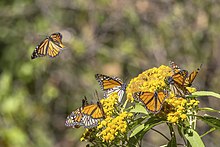
Back Vierpootskoenlapper Afrikaans حورائيات Arabic حورائيات ARZ Nymphalidae AST Nimfalidlər Azerbaijani Німфаліды Byelorussian Многоцветници Bulgarian Nimfàlids Catalan Nymphalidae CEB Nymphalidae Corsican
| Nymphalidae | |
|---|---|

| |
| Scientific classification | |
| Domain: | Eukaryota |
| Kingdom: | Animalia |
| Phylum: | Arthropoda |
| Class: | Insecta |
| Order: | Lepidoptera |
| Superfamily: | Papilionoidea |
| Family: | Nymphalidae Rafinesque, 1815 |
| Subfamilies | |
and see article text | |
| Diversity | |
| Over 600 genera About 5,700 species | |





The Nymphalidae are the largest family of butterflies, with more than 6,000 species distributed throughout most of the world. Belonging to the superfamily Papilionoidea, they are usually medium-sized to large butterflies. Most species have a reduced pair of forelegs and many hold their colourful wings flat when resting. They are also called brush-footed butterflies or four-footed butterflies, because they are known to stand on only four legs while the other two are curled up; in some species, these forelegs have a brush-like set of hairs, which gives this family its other common name. Many species are brightly coloured and include popular species such as the emperors, monarch butterfly, admirals, tortoiseshells, and fritillaries. However, the under wings are, in contrast, often dull and in some species look remarkably like dead leaves, or are much paler, producing a cryptic effect that helps the butterflies blend into their surroundings.
© MMXXIII Rich X Search. We shall prevail. All rights reserved. Rich X Search